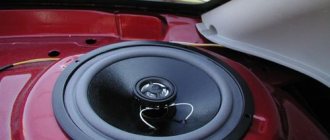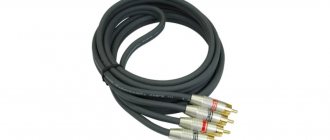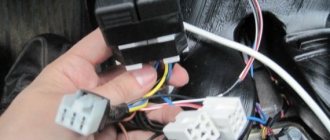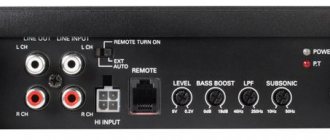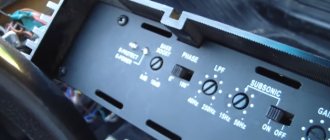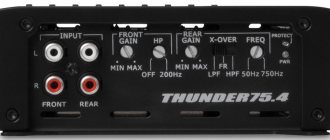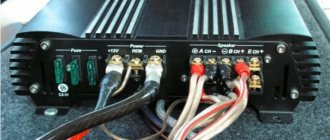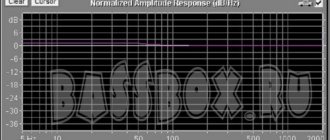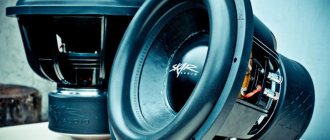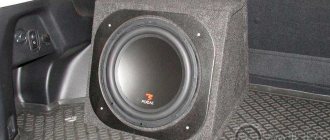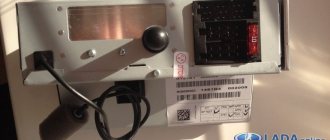To properly connect a subwoofer in a car, you need to solve several problems. First, the choice of low-frequency channel power is determined. If the car owner expects a comfortable sound picture in the cabin, then the output power of the system should not exceed 80-100 watts. In this case, the speaker can be placed on the shelf behind the back of the rear seat. With a higher output power, to obtain maximum sound pressure, the low-frequency speaker is placed in the luggage compartment of the car. Connecting an active subwoofer to a car includes supplying power to the built-in low-frequency amplifier and connecting the input terminals to the radio.
Connecting an active subwoofer to a car
Connecting a subwoofer to a car begins with preparing the connecting cables to supply power voltage and sound signal. The low-frequency system with a built-in amplifier is a design completely ready for installation. On the back or side wall of the case there are terminals for connecting the supply voltage and the output of the music center. Special cables are used to connect the subwoofer to the car. The power wire must be copper and stranded, and its cross-section is determined based on the output power of the amplifier. To determine the material, just look at the cable cut. Aluminum and copper wires differ in the color of the metal. If the ends of the cable are pressed into lugs, then you can determine a good copper wire by weight. A wire made of copper-plated aluminum is much lighter. You can connect the battery to the ULF using the power cables that are included in the set of wires for car audio, or you can purchase a piece of wire of the required length. To supply power to the amplifier, a high-quality welding cable of the KG-25 type is often used.
How to connect a subwoofer to a car
What you need to connect a subwoofer in a car. In addition to tools, you will need the following products:
- Power cable
- Interblock shielded wire with RCA connectors (Tulip)
- Bulb with fuse
- Nut lugs for power cable
- Plastic bushings and ties
The connection diagram for an active subwoofer is not difficult. The red wire supplies “+” power from the car battery to the corresponding terminal of the low-frequency amplifier. To prevent overheating of the cable from causing the insulation to burn, a fuse is provided in this circuit. It protects the cable, not the amplifier. The ULF power supply circuit has its own fuse. According to the installation rules, the bulb with the fuse should be no further than 15-20 cm from the battery. To connect the power cable to the battery, a tip under the nut is soldered onto its end and plastic heat shrink is put on. The negative power terminal of the amplifier is connected to vehicle ground. To do this, you can use any bolt with a washer. If the power of the low-frequency channel exceeds 800 watts, it is recommended not to connect the negative of the amplifier to the vehicle ground, but to lay a separate cable from the battery. Thus, the connection between the subwoofer in the car and the battery will go through two wires.
We select the wires ourselves
The best option is to assemble the kit yourself, choosing copper wires taking into account the power of the audio system.
Power wires
The most significant component. Their incorrect choice will not only affect the sound quality, but can damage all components of the audio system.
So, knowing the power of the system and the length of the wire, we will determine the required cross-section. To select a cross-section, use the table below (calculation is given only for copper wires).
Advice from CarAudioInfo. Car audio stores have a lot of power cables from well-known brands. They are good in everything except the price. As an alternative, industrial wires can be used. Most often in installations there are KG and PV wires. They are not as flexible as branded ones, but they are much cheaper. You can find them in “Electrics” and “Everything for Welding” stores.
Interblock “tulip” and control wire
The purpose of the interconnect wire is to transmit the initial signal from the head unit to the amplifier. This signal is vulnerable to interference, and the vehicle contains a large amount of electrical equipment. If we install “tulips” intended for home use or budget car speakers, there is a high probability that extraneous noise will arise when the subwoofer operates.
When choosing, we advise you to give preference to well-known brands. Pay attention to the composition - not everyone in the budget segment has copper; the manufacturer indicates this on the packaging. Pay attention to the connectors themselves. It is better to choose metal and shielded wires - this will make the connection stronger and protect the signal from interference.
The next thing is the presence of a control wire. Does it go with “tulips”? Great! If it is not there, no problem, we purchase any single-core wire with a cross-section of 0.75-1.5 square, 5 m long.
How to properly connect a subwoofer in a car
When laying all wires, from the engine compartment with the battery to the installation site of the low-frequency speaker, you must follow the installation rules. Cables are passed through existing technological holes. If this is difficult or inconvenient, you can drill the holes yourself. Protective rubber bushings must be installed at the intersection points between cables and metal surfaces. The most reliable way is to lay the wires in a corrugated plastic sleeve. The wiring must be firmly fixed, so plastic ties are used to secure it. When installing a subwoofer in a car, in addition to the signal wire and power supply cable, a single unshielded control line wire is laid between the car radio and the active speaker.
When you turn on the power to the radio, the potential from this wire turns on the power supply to the active system. Often this wire is not connected, and a separate toggle switch is used to supply voltage to the amplifier. Connecting an active subwoofer in a car without a fuse is not allowed, since about 70% of all fires in a car occurs due to a short circuit in the unprotected power wires of the speaker systems. The fuse must be installed in the engine compartment next to the battery. With a cable cross-section of up to 10 mm2, it is permissible to install a fuse for a current of no more than 60 A. With a cross-section of 20 mm2, a 100 A fuse is required. A fuse for a lower current can be installed, but a fuse for a higher current cannot be installed, as this can lead to a fire.
Useful tips
These tips mainly concern your personal safety during the installation of audio equipment in your car.
- Regardless of the type of work being carried out, when making any interventions on electrical equipment, first turn off the power to the vehicle. To do this, simply remove the negative terminal from your battery;
- When connecting different wires, be sure to make sure that they are securely and securely fastened. Therefore, clamps, corrugations, electrical tapes and seals become mandatory materials in the work;
- Since you are installing an audio system for yourself and expect it to operate for a long time, use only high-quality wiring. Otherwise, a short circuit cannot be avoided;
- Choose suitable fuses. To determine its nominal characteristics, look at the passport of the connected equipment. From there it will become clear what parameters the fuse should be taken with;
- Mounting audio equipment should be as simple and secure as possible. Various oscillations and vibrations should not be allowed due to poorly tightened bolts or an incorrectly selected installation location.
These are quite simple, but very useful and practical recommendations. Everything is aimed at ensuring that you achieve your goal, and that the audio system in the car sounds as high quality as possible.
Much depends not only on the choice of a high-quality subwoofer. Even such seemingly insignificant things as wires and insulating materials play a huge role. Don't save where you shouldn't. And then the result will definitely meet your expectations.
Installing a subwoofer in a car
The subwoofer in the car is connected to the sound source using an interconnect cable. Here a lot depends on the type of car radio. Some models are equipped with a separate connector for connecting a low-frequency channel. This connector is marked “SUB”, “Sub. Out" or similar combinations of characters. In this case, a shielded cable with “Tulip” connectors at the ends is used to connect the active low-frequency system. Another connection option involves using connectors to connect rear speakers. Connecting an active subwoofer to a car is done using a bridge circuit. Typically, standard car radios or stereos are equipped with standard connectors with blade contacts. The block consists of three parts. To connect sound speakers, connectors “B” and “C” are used.
The pinout of the contacts of block “B” on the speakers is as follows:
- B1 – rear right “+”
- AT 2 -" - " - " - " - " - "-"
- B3 – front right “+”
- AT 4 - " - " - " - " - " - "-"
- B5 – front left “+”
- AT 6 - " - " - " - " - " - "-"
- B7 – rear left “+”
- AT 8 - " - " - " - " - " - "-"
Signals from the linear output of the radio amplifier are output to the contacts of block “C”.
- C1, C2 – left and right rear speakers
- C4, C5 – left and right front speakers
- C3 – body (ground)
- C6 – remote power up of the amplifier
There are two ways to connect an active subwoofer to a car. In one case, the contacts of connector “B” are used, intended for rear speakers placed in the car interior. You can connect an active subwoofer to a car from block “C” using a special adapter with RCA connectors. If the sub in the car is installed in the luggage compartment, you will need to extend the wires.
Using a Crossover
When connecting a subwoofer using a crossover, that is, a special filter, you should understand what we are talking about.
The purpose of a crossover is to separate sound frequencies into certain ranges. This defines its role as a filter. Tweeter-type speakers are often used for cars. If you do not use a filter for them, the speaker heads will be fed signals from low to high frequencies. The lack of signal distribution negatively affects the sound quality of the music.
In this case, crossovers are divided into active and passive, and can be single-way or two-way.
- Passive crossovers include active elements in their design. Such a device consists of induction coils, capacitors and resistances. This leads to disadvantages in the form of loss of signal power. Plus, they have restrictions on peak loads, which can cause quick filter failure. To connect a passive crossover, it must be installed in front of the dynamic heads. But such a connection allows the use of only one amplifier, and this is already considered an advantage. Such filters can come separately or be part of an acoustic system.
- Active crossovers are placed in front of the amplifier, and therefore it will not be possible to use only one amplifier. Here the speakers are connected to a separate amplifier channel, and this does not depend on the type of frequency. The advantage is considered to be more precise tuning. It is because of this that active crossovers are more expensive than passive ones.
Each motorist must decide for himself what to choose.
How to properly connect a subwoofer to a car
An active subwoofer connection in a car may require a channel combiner that mixes the right and left signals while limiting the level to safely feed the signal to the amplifier input. The device can be purchased at a specialized store or made independently. The diagram for connecting an active subwoofer to a car contains a minimum number of parts and does not require configuration or adjustment.
The circuit uses three constant resistors, which are soldered directly to the connector. To avoid interference and impulse noise, the connection between the subwoofer and the car radio is made with an insulated shielded wire.
In addition to the active low-frequency system, you can install a passive subwoofer in the car. It is a box (box) in which a powerful electrodynamic head is installed. The passive system box can be assembled using a closed circuit or with an acoustic bass reflex. If the speaker is designed for a power of 15-25 watts, it can be connected directly to the output of the car radio. To obtain high output power, such a speaker is usually used in conjunction with a low-frequency amplifier. The car ULF unit is installed next to the low-frequency speaker. The usual location is the luggage compartment. Power to the amplifier is organized according to the same rules as to the active device.
Examples of circuits for connecting active and passive subwoofers
Please note that not all car radios have LV. As a rule, factory models do not have this connector.
In such cases, it is recommended to additionally purchase a special adapter to connect a passive subwoofer, which connects to a radio that does not have a LP. In turn, the subwoofer will be connected to this adapter. How to do this correctly is shown in the diagram below.
Active connection diagram. subwoofer to a car radio without a LV channel via an adapter.
Passive connection diagram. SBV through an amplifier.
How to connect a subwoofer without an amplifier
Step-by-step instruction:
- On the rear panel of the car radio there are two inputs through which the subwoofer and the radio are connected using a linear cable.
- Then the power is connected: the power cable is laid under the interior trim and connected to the “+” terminal of the battery with one edge, and the other is connected to the subwoofer.
- The negative contact is connected to the battery “-” terminal and is grounded to the housing with a bolt connection. For these purposes, the edge of the wire must be stripped in advance. Cleaning is done with a knife and wire cutters.
- Since the power supply to the battery is 12V, the connection is only permissible through a fuse, which is installed on the power cable near the battery.
- Next, the connecting RCA wires are laid from the subwoofer through the interior and connected through the LOW-Input connectors, having previously cleaned the edges. If the connectors in the radio do not have RCA connectors, then you can connect them via the HI-Input connector.
Important! When connecting a device, do not confuse the active with the passive; remember that the active already has a built-in amplifier, while the passive does not, so the connection diagrams are different in both cases.
Problems you may encounter when connecting
The following difficulties may occur when connecting the device:
- A factory car radio usually does not have a special audio connector for an amplifier - this can be solved by purchasing a special adapter;
- Setting and correlation of low and high frequencies with the main acoustics of the car.
Please note: to properly connect the subwoofer to the car radio, you must have basic knowledge of electrical engineering. Otherwise, it is better to contact a car service center for specialist help.
Correct connection of an active subwoofer in a car
Often, during the operation of a powerful active system, at high volume levels, a short-term decrease in the sound level occurs, up to complete loss. This is due to the fact that at the peak power of the amplifier, the current consumption increases greatly, and the car battery cannot provide adequate power. To avoid this effect, the subwoofer in the car is connected in parallel with a large capacitor. With this method of organizing power supply to the device, the capacitor plays the role of an additional power source. It stores electrical energy and, at the moment of excessive consumption, supplies it to the amplifier’s power circuit. The capacity of such a capacitor is usually 1-2 farads.
In addition to connecting an active subwoofer in a car, the same principle is used to supply power to a low-frequency amplifier for a passive speaker system. All electrical connections are made with multi-core copper cable that can withstand high current with minimal losses. To avoid voltage drop in the wire, the distance between the positive contact of the capacitor and the “+” power supply of the amplifier should not exceed 15-25 cm. The capacitor itself is mounted as close as possible to the low-frequency amplifier. In order to limit the entry of the high-frequency part of the audio range, a crossover filter with a certain cutoff frequency is turned on at the input of the speaker system. A passive LC filter “cuts” frequencies above 180-250 Hz.
